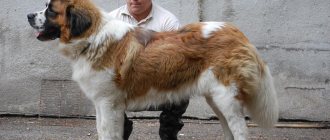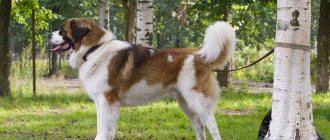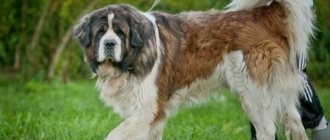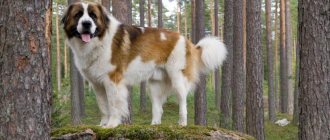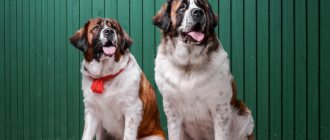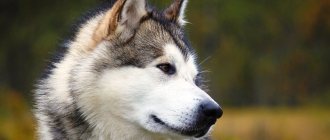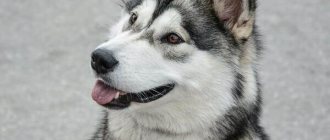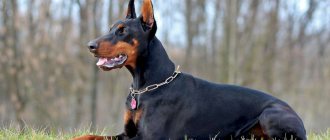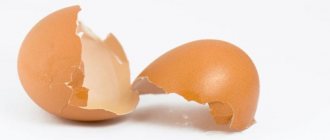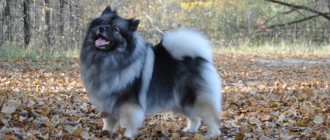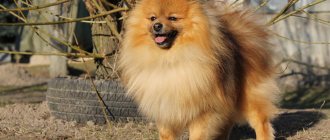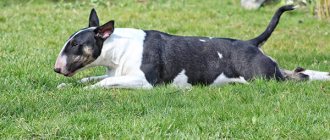What to feed the Moscow Guard Dog
As for an adult dog, feeding the Moscow Guard is not particularly difficult for its owners.
The breed was bred as an unpretentious working dog and did not have time to get into the fashion wave, so most of the properties inherent in it have been preserved in the livestock to this day. The ideal product for her is, of course, meat. We are not talking about tenderloin and other expensive varieties. Lean beef trimmings, offal, tripe and tripe, poultry, and game are suitable. An adult male dog needs one and a half kilograms of meat per day to feel good and work productively. One kilogram is enough for a bitch, and in the summer - 800 grams. In winter, the question of what to feed an adult Moscow watchdog gets reconsidered. Porridge is included in the diet because it can be served warm and allows dogs to compensate for the lack of water. Ideal cereals are buckwheat, chopped rice with the addition of oatmeal and eggs in small quantities. If the dog does not have allergies, you can also use wheat cereal, but it is practically not digested in the dog’s stomach and serves more as ballast than as a nutritious product. Breeders begin self-feeding Moscow Watch puppies at approximately 21 days of age. As the first complementary foods, scraped beef meat, starter feed soaked in low-fat kefir, cottage cheese with low-fat kefir, quail eggs or liquid porridge with goat's milk can be used. These products do not cause digestive upset in puppies and are used up to 2 months of age. You should not introduce several types of complementary foods into the diet at once - it is better to let the puppies get used to one type and only then introduce the next one.
You should definitely ask the breeder about what to feed a Moscow Guard puppy for 2 or 3 months. The main thing is that after moving to a new place, do not create stress for the puppy by dramatically changing his usual diet. At this age, the puppy is transferred to ready-made puppy food, gradually replacing the starter with it, they begin to give raw meat steamed with boiling water, reduce the amount of milk in the diet, switching the puppy to fermented milk products, introduce fish and offal, still boiled and cut into small pieces. At this age, the puppy is fed 4-5 times. If the baby ignores one of the feedings, their number is reduced by one, correspondingly increasing the portion of the rest.
After the puppy reaches the age of 3 months, the question of what to feed the Moscow Watchdog again faces its owners. At this age, the proportion of dairy products gradually decreases, food is given in large pieces, and in order for teeth to change faster, pressed sinews and sugar bones are given. It is important to understand that they are not food for your puppy and do not replace a full feeding. Gradually, seasonal vegetables are added to the diet (carrots, pumpkin, apples, turnips, beets, tomatoes, zucchini or squash). They are given boiled or stewed. It is better to add a little cream, sour cream or butter to carrots and pumpkin - this way the fat-soluble vitamins included in their composition will be better absorbed.
And a little about what you should not feed the Moscow watchdog. Smoked, salty, spicy foods are contraindicated for dogs. It disrupts the normal functioning of digestion and can cause gastritis, pancreatitis and liver diseases. You should also not feed your dog flour or sweet foods. It is undesirable to give her grapes and raisins, raw river fish, which can cause group B vitamin deficiency and infect the dog with helminths. Eggs are given to an adult dog no more than twice a week, one at a time.
Read more about the Moscow Watchdog
Feeding dogs of different breeds Dog breed Moscow Watchdog Photos of the Moscow Watchdog How much does the Moscow Watchdog cost Names, nicknames for the Moscow Watchdog Description of the Moscow Watchdog characteristics History of the Moscow Watchdog breed Feeding the Moscow Watchdog Care and maintenance of the Moscow Watchdog Diseases of the Moscow Watchdog symptoms Reviews of the Moscow Watchdog Standard Moscow Watchdog Pete nicknames of Moscow Watchdogs and their breeders Details about the Moscow Watchdog
What cereals should you avoid?
Porridge is undoubtedly good for dogs, but there are also some that should not be given. These are barley, semolina, milk, corn, pearl barley. Let's look at why these cereals are harmful to pets.
Barley is difficult to digest and can cause constipation in your dog. Also, egg is difficult to digest and is considered heavy on the stomach. The dog may feel a heaviness in its stomach and will be significantly less active. This fact can lead to excess weight and bone disease. How to cook barley - no way for dogs!
Semolina is an absolutely useless porridge. It contains virtually no microelements. For that there is an abundance of vitamin B. Consequently, the pet gains weight very quickly, not having time to absorb vitamins and other beneficial substances coming from other foods. Semolina clogs the stomach very much. This leads to diseases of the gastrointestinal tract.
Milk porridge often causes bloating in dogs, which is completely unacceptable. Many dogs are lactose intolerant, resulting in severe allergies. An allergic reaction to the protein may also occur, causing vomiting and inability to digest other foods. Veterinarians note that milk was often the cause of volvulus. This does not depend at all on the fat content of the product. So before pampering your pet with a dairy product, you should consult a veterinarian. In addition to milk, your dog can eat cheese and fermented milk products in a certain amount.
Corn porridge is not very well digested and causes bloating. To prevent your pet from suffering, you should abstain from this cereal. If for some reason you had to give your pet corn grits, you should dilute it with vegetables 1:1 and add 2 tablespoons of olive oil. This way the balance is restored and the dog is not harmed. But, even taking into account our recommendations, it is worth consulting a doctor, since all indications are individual for each pet.
What to feed a Moscow Watchdog puppy?
The process of separation of mother and baby is not so painless for the second one in terms of psychological and nutritional issues. Therefore, you must surround him with care and not change the puppy’s nutritional diet during the first days of his stay in new conditions.
It is necessary to feed the offspring of the Moscow watchdog in the age period from 1 to 3 months 5 or 6 times during the day; there are cases when babies refuse the sixth meal. At the age of 3 to 6 months they are fed 4 times a day, from 6 to 10 months - three times a day. Then they are transferred to an adult pet and fed twice a day. Each small pet requires individual feeding.
The main component of an animal’s diet is raw meat, which gives it growth and strength, health and resistance to various ailments. By two months, he should consume 350 g of meat daily; he can be given a sinewy product, but not fatty and must be cut into small slices. You also need to feed it with sea fish. It can be navaga and pollock, cod. River fish is not given due to small bones and possible infection with parasites. And 150 g of healthy cottage cheese is fed along with kefir or yogurt, adding a raw egg once every 7 days. All dairy products must be fresh. Milk is not given in its pure form, but is used to dilute cooked food. For cereals, we recommend buckwheat and rice, rolled oats and millet, a mixture of barley and corn grits. Pasta is prohibited.
From 2 months, your young pet can already be fed potatoes and cabbage, beets and pumpkin, zucchini and tomatoes, raw or lightly stewed with vegetable oil. Sauerkraut, lettuce and onions, beet and carrot tops, and young nettles scalded with boiling water are a storehouse of vitamins and nutrients.
From the age of 5 months, the watchdog can already be treated to liver, kidneys, and lungs.
And don't forget about a bowl of clean, fresh water. It should be in a place accessible to a friend at home.
Recipes: how to cook?
We figured out what grains to cook porridge from. Let's move on to how to actually prepare tasty and healthy porridge:
- 1.5 cups of any porridge,
- 1 ripe tomato
- 1 medium carrot
- 1 medium potato,
- chicken soup set.
Pour water into the pan and throw in the chicken frames or heads. As soon as the water boils, add chopped carrots, potatoes and maybe a little cabbage. It boils a little - add the cereal.
If the dog likes it, you can add fresh herbs. As you know, greens are a whole bunch of vitamins. Place diced vegetables into the prepared warm wheat porridge. A wonderful summer meal for your pet is ready.
Boil vegetables:
- Cauliflower
- Carrot
- Potato
- Parsley
- Spinach leaves
Add a glass of buckwheat to the vegetable broth and cook for 10-15 minutes. Then leave covered for 1 hour. When the soup is warm add 2 tablespoons of olive oil. A hearty, healthy soup is ready.
- 300 grams of any lean meat. You can have turkey, chicken.
- 2 cups cooked brown rice
- 1 cup cooked oatmeal
- 1 cup grated fresh carrots
- 1 cup diced vegetables (whatever your pet likes)
- 2 tablespoons olive oil
How to cook:
Cut the meat into pieces so that it is convenient for the dog to eat. This nutritious mixture of rice and vegetables will delight your pet either for breakfast or for dinner.
Oatmeal is exactly what can serve as both a complete meal and a delicacy.
- 2 cups whole oatmeal
- 2 parts lean meat (chicken, beef),
- 1 grated carrot,
- 1 tbsp. olive oil.
Boil oatmeal, add pre-boiled meat until it becomes mucus. For your pet, this will be a fortified version of dinner or breakfast.
The character of the Moscow watchdog
The Moscow Guard is a fairly active breed of dog; most representatives of this breed are highly active. Of course, the dog feels best outside the city, but in the city the Moscow watchdog feels a high need for walks. Despite the activity, excitability is not inherent in the Moscow watchdog, so the owner is unlikely to encounter such a problem as unmotivated barking. The behavior of the Moscow watchdog is very balanced and calm.
When purchasing a puppy, immediately prepare yourself for training - the behavior of the Moscow watchdog is independent. Dogs of this breed are quite stubborn, which often causes anxiety for their owners.
Moscow watchdogs are sociable, cheerful and demanding of affection; like most dogs, they are attached to their owner. The Moscow Watchdog is a fairly intelligent and quick-witted dog. Most representatives of the breed are able to behave correctly in non-trivial situations and emergency circumstances. The Moscow Watchdog is also relatively easy to train, much easier, for example, than its ancestors, the St. Bernard and the Caucasian Shepherd. The dog is able to quickly master any skills.
Black Russian Terrier
In the mid-twentieth century, in an army nursery located in the Moscow region, work began on breeding a new breed intended for guarding prisons and camps.
The change in the situation in the country, on the one hand, eliminated the service of animals in the police and army, and on the other hand, made it possible to introduce the breed en masse. Thus, in 1955, the Black Russian Terrier was shown at the VDNKh (Exhibition of National Economic Achievements), and in 1957 at the Moscow Service Dog Exhibition. Since that time, dog breeders have had the opportunity to purchase a Black Russian Terrier.
The breed turned out to be international: 17 dog breeds took part in the breeding of the terrier. The main qualities included in the characteristics of the breed are a comfortable stay in our climatic conditions, subordination to one leader and excellent guarding qualities.
The Black Russian Terrier was recognized by the international canine organization in 1984.
The breed standard includes the following characteristics: males weigh on average 50 kilograms with a height of 66-72 centimeters, for females - with a weight of 45-50 kilograms, height is 64-70 centimeters. Life expectancy is 10-11 years.
Terriers are physically hardy dogs that require daily long-term physical activity and jogging. Intensive work helps them stay in shape.
They need a mandatory course of training and socialization. Black terriers have a strong character, so they obey only a firm and authoritative owner. A properly trained terrier is a manageable dog in any situation.
The owner needs to be careful when walking with the terrier in crowded places. This massive dog can, even unconsciously or at the slightest suspicion of danger to the owner, harm a stranger or child, for example, push away, scare, drop.
The dog is very attached to its owner, friendly with children, but it is not recommended to leave the terrier alone with a child; the dog does not like it when its loyalty is abused.
In case of danger, the dog is capable of an instant reaction, has a strong grip, and if it is very excited, the owner will have to work hard to tear the pet’s jaws away from the attacker.
The Black Russian Terrier is nicknamed “Black Lightning,” which it received because of its lightning-fast reaction and jump, which creates the impression that the dog is pushing off the ground with all four paws at the same time.
The development of the breed has changed the character of the terrier to a more friendly one, while maintaining protective qualities and the ability to stand up for itself and its owner.
Thanks to their thick coat with a dense undercoat, terriers live quietly in outdoor kennels with fenced, spacious enclosures. In such conditions, pets can move a lot and actively.
Caring for Moscow Watchdog puppies
It is best to start caring for your Moscow Guard puppy on your own at 2 months of age. Firstly, the puppy must have its own place, bedding, toys, bowls, collar and leash. You will immediately have to exclude options near the door, radiator, toilet; a draft-free balcony or a courtyard is best.
You cannot limit a dog’s freedom, you must let it go for a walk, the dog must be active and move a lot. From the first days, the puppy needs to be taught to walk outside. At first, just take it outside for 10-20 minutes (even if it’s very cold outside); you shouldn’t let the puppy walk on the ground until he has had all his vaccinations. Until 10-12 months, heavy loads are contraindicated for a puppy.
Caring for the Moskvich's coat is simple and does not require special knowledge or professionalism. The wool needs to be combed with a comb (comb), helping yourself with a slicker brush - once a week will be quite enough. You should not be zealous during the molting period, just comb it once and bathe it in a special mild shampoo. Of the many cosmetics for dogs, it is important to choose the right shampoo that will not dry out the skin. Generally speaking, you should only bathe your dog when necessary.
Caring for a Moscow watchdog after giving birth requires a lot of knowledge; first of all, you need to carefully monitor the dog’s behavior! If you are at a loss and don’t know what to do, contact your veterinarian. The bitch can also show irritability and aggression, or hysteria. This can manifest itself, for example, in puppies licking - in this case it is necessary to put a muzzle on her.
Adviсe
Peculiarities of raising a Moscow Guard puppy
It is best to adopt a puppy when it is 1.5-2.5 months old. The puppy must have its own toys, bedding, bowls, leash and collar. The place for the dog should not be near the door, radiator, in the passage, toilet, in a draft, or in the bathroom. The ideal place for “Muscovites” is a large balcony without drafts or a courtyard. Dogs feel great in nature because... Moscow watchmen are not afraid of frost, dampness, or heat. With proper care and nutrition, dogs can safely swim in open water in severe frosts and withstand increased stress in extreme heat. However, the maintenance of the Moscow watchdog requires some features. In no case should their freedom be limited, because... This is not a chained dog, although it can live on a chain all its life, but at the same time its exterior deteriorates very much: its back sags, its chest and muscles are underdeveloped. The Moscow watchdog has a great sense of “its territory.” It is advisable to choose a place for keeping in the yard where the dog can observe most of the territory. From the first days of keeping a Moscow Watchdog puppy, it is necessary to accustom it to walks in the fresh air, but before vaccination, the puppies should not be placed on the ground, with the exception of fenced areas where there are no dogs. Walking time increases gradually depending on age and time of year; it should be divided into several sessions. The puppy should be walked on a leash, only allowed to run in places where there is no risk of suddenly getting hit by a car. Excessive loads are contraindicated for a puppy under the age of 10-12 months, when the tubular bones are actively growing. When raising a young dog, the main thing is to show the puppy his place in the “hierarchical ladder”. The owner occupies the highest level - “leader”, and “below” him in the eyes of the dog are other family members. If raised incorrectly, dogs try to take a higher place. If a dog snaps, rushes at its owner, or starts biting, you cannot show the dog fear. In this case, if you get scared, pull back the hand grabbed by the dog, the dog will win the first “round”. It will become more difficult - the dispute for supremacy will continue with increasing persistence. Therefore, you cannot pull out a hand grabbed by your teeth; you must calmly release it with your other hand, shake the puppy by the collar and strictly give a prohibitory command. Sometimes the “dog owner” begins to develop the puppy’s anger: he teases, provokes and encourages the defense of a toy, a bone, a bowl of food, etc., and subsequently cannot cope with the dog. In other cases, the “dog owner” shows uncertainty, or even fear, in communicating with the pet. Dogs sense this very well and become domestic despots. Often, a grown-up puppy, as it were, tests the owner - he growls, or even grabs the owner with his teeth, when he forces the pet to carry out some order, or bothers the dog, who is lying down in the wrong place. In these cases, there is only one way to deal with the dog - to put him in his place. The sooner you can teach a puppy to know his “rights and responsibilities” in the family, the fewer problems there will be with his maintenance in the future. The most difficult part is establishing a strong bond with your dog, which begins in puppyhood. And for this you need to know something about the 2 intrabreed types of the Moscow Watchdog. The Moscow Watchdog inherited poise and good nature from its St. Bernard ancestors, and malice from the Caucasian Shepherd Dogs. The combination of these qualities makes the breed universal in its adaptability to the owner’s requirements. Depending on the conditions of detention, on the purposefulness of training or lack thereof, two types of dogs are obtained, somewhat different in behavior. The first type of dog is formed through systematic training, regardless of the form of keeping. These dogs adapt well to life in urban environments. They love their owners and their entire family very much, they can be nannies for children no worse than advertised collies, and they know all the owner’s friends. In transport, such dogs do not create inconvenience, do not bark or rush. In general, they are distinguished by the rapid and strong development of inhibitory reflexes, which is positive in urban conditions. At the same time, Moscow watchmen are aware of their strength. Malice does not disappear with any cultivation. What is surprising is the instant transition from goodwill to malice when there is an obvious threat to the owner or the dog itself. The second type is obtained through the purposeful development of anger or maintenance in a nursery or private homes. Dogs of this type are similar in character to Caucasian Shepherds, that is, they are less balanced and more aggressive. Both types of dogs have strong innate wariness and distrust, which determines their excellent guarding qualities. The appearance of the Moscow watchdog is attractive and does not cause fear, however, this impression is deceptive, since under the external calm and good nature lies an excellent watchman and a selfless guard ready for instant action. When training a Moscow watchdog, an individual approach is of great importance, which is based on the need to correctly analyze the dog’s behavior, take into account the state of its body, age, growing and upbringing conditions, the predominant reaction of behavior, features of the type of nervous activity, motor activity, natural habits, habits, etc. In accordance with all this, determine the teaching methodology. The peculiarity of training the Moscow watchdog is expressed primarily in the fact that it will take slightly more time and perseverance to practice and reinforce commands in dogs than owners of other service breeds. However, this fully pays off in that the acquired skills are reinforced by the Moscow Watchdog for life, without additional constant training, which is necessary for other breeds. The second feature of the Moscow Watchdog is that this breed is not intended for dog fighting. And those owners who try to prepare this breed for dog fighting risk “disrupting” the dogs’ nervous system and “killing” their watchdog qualities. As a result, they get an uncontrollable, unbalanced, highly and quickly excited dog that reacts to “everything that moves.” This leads to the fact that such dogs are unsuitable for keeping in the city and for use in breeding work.
Breed characteristics
The peculiarity of the breed is that it was created by special order of the government. The reason was the threat of extinction for many animals in the post-war period. As a result of crossing many breeds, the work was very difficult. The goal was to create an animal that was easy to care for, had a powerful constitution, was active and learned quickly. By 1958, there were about 28 of these living in the nursery.
Appearance
The modern Moscow Watchdog is a cross between the St. Bernard and the Caucasian Shepherd. In the photo you can easily find similarities between these breeds. The Moscow Shepherd has stronger bones and developed muscles. The main parameters are as follows:
- height - 68 cm at the withers for males, 66 cm for females (but values of 77-78 cm and 72-73 cm are considered more preferable);
- weight – from 60 kg for males and from 45 for females.
Breed standard
In addition to height and weight values, the breed standard contains a complete description of the dog’s physique and its characteristics. It looks like this:
- The head is massive, deep and wide in the skull. The brow ridges are very developed, the forehead has a slightly convex shape. There is a massive bump on the back of the head.
- Muzzle. Voluminous, wide, has good filling under the eyes. The nose is large, fleshy, black, the nostrils are rounded. The lips do not hang below the lower jaw. They are also fleshy, large, and have a black rim.
- Jaw. Large teeth are adjacent to one another. Their set is complete - 42 pieces. The cheekbones are well developed, the bite is scissor-shaped - the lower incisors close, extending beyond the upper ones.
- Tail. Saber-shaped, has a natural shape, strong, with rich fringe.
- Eyes. Wide set, dark, small, round in shape. The animal's gaze is confident, but calm.
- Ears. The edges are rounded, but overall triangular, pendulous.
- Neck. The length practically corresponds to the massive head, medium, oval in cross-section with well-developed muscles. The scruff is especially pronounced.
- Frame. Slightly stretched, proportional, deep and voluminous.
- Withers. Muscular, tall, wide.
- The chest is wide and long. The ribs are large and convex, widening towards the rear.
- The back is strong, wide and large, and also has voluminous muscles.
Coat and color types
The Moscow Watchdog has thick skin. It does not sag, only suspension is allowed. The undercoat is well developed. The awn is close-fitting, thick and straight. On the chest, the thick fur appears fluffy, and on the back of the limbs and tail there are feathers. It protects the pet from harsh climatic conditions during the cold winter, but when kept in an apartment it causes inconvenience. The Moscow Shepherd is two-colored and has several markings:
- base – white on the neck, chest, tip of the tail, lower limbs;
- additional color - sable, red, black-red, red spots;
- Markings – ear area and dark glasses.
History of the origin of the species
This breed is quite young, it appeared in the middle of the last century. The Soviet Union needed strong working dogs, especially after World War II. It was then that the first shortcomings of the dog breed from the USSR and the predominance of European countries in the number of service dogs became apparent. At that time, the German Shepherd was already popular in the country, but could not work in the harsh Russian frosts. Therefore, it was decided to breed a new, guard, frost-resistant breed.
1949, the Krasnaya Zvezda kennel receives an order to breed a large service dog. The new dog had to combine the intelligence, aggressiveness and utilitarian qualities of the German Shepherd with the good nature, endurance and high endurance of the St. Bernard.
The standard was published in 1958, and the breed was recognized in Russia in 1985. Moscow watches are still not recognized by world clubs.
Moscow Shepherd - character
The main character traits of the Moscow Shepherd are confidence and restraint. Even with large sizes, dogs are distinguished by their obedience. They have the following qualities clearly expressed:
- Security guard instincts. The menacing growl and frightening appearance leave no doubt that the guard dog will not be nice to strangers. The animal has well-developed security and guard qualities.
- Devotion to the owner and family. The dog's main instincts are protective. They are very devoted to all family members and are a devoted friend to them.
- Balanced psyche and lack of aggression. In normal circumstances, the dog is very calm, not aggressive, but is easily excited at the slightest threat to those whom it considers its family. She will not bark for no reason, but if necessary she will react to what is happening with her voice.
- Love for children. At home, the Moscow Watchdog is a good-natured and affectionate “bear”. Children love to play with him. The dog treats them like a nanny.
- High intelligence. The breed is distinguished by its intelligence and ability to train. Its representatives are even considered intellectuals.
- Stubbornness and independence. These qualities are smoothed out by proper training and the owner’s own character.
How and why should you cook with water and not with broth?
Every owner wants their dog to have food that is not only healthy, but also tasty. Because of this, the question arises: is it possible to cook porridge not with water, but with broth? The fact is that due to prolonged cooking, undigested fats and much more remain in the water, which will not benefit the dog.
All elements enter the liver directly from the stomach and affect the cells. Dilution of gastric juice has a detrimental effect on digestion. Broth can develop erosive gastritis. If the broth is low-fat or third-cooked, it can sometimes be given with porridge. Just mix and not cook the cereals in broth. The main diet should be based on cooking porridge in clean water.
Moscow Guard puppies
The best option is to choose a puppy aged 1.5-2 months. Before purchasing, you should decide on the gender of the animal, because the Russian Watchdog has very pronounced differences in the appearance of males and females. The latter guard the territory entrusted to them with great zeal, but at the same time they are more aggressive towards members of the owner’s family. The bitch recognizes the authority only of the owner. Males are also cocky, but towards other dogs. When choosing a bitch, it is worth considering that when performing service, she will sometimes be released from it. The cause may be estrus, childbirth and feeding of puppies.
How to choose
Having decided on the gender, you need to weigh the pros and cons. Certain dog qualities are important to different owners. To choose the right puppy, you should consider the following criteria:
- Documentation. When purchasing, you need to consider the pedigree of the puppy's parents.
- Territory protection. If you buy a dog as a watchdog, then you should ask the breeder for certificates of the mother and her work.
- Contact. The optimal choice is a puppy who himself began to communicate, even at the first meeting, and showed curiosity. Although cautious and mistrustful pets will be excellent guards.
How much do Russian Guard puppies cost?
Today you can buy a puppy in many nurseries. The price will be higher, but you will be sure that you have purchased a pure breed and not a crossbreed. Such a puppy acts as a carrier of genes, is in good health, and has no errors in rearing. You can purchase an animal at a lower price on the market or through an advertisement. It is worth considering here that it is possible to buy a puppy with flaws in character and appearance. The average cost for a Moscow Shepherd in different kennels is presented in the table:
| Nursery name | Price, rubles |
| Posad Guard (Sergiev Posad) | |
| Olen | |
| Porcelain fairy tale | |
| Departmental nursery at Russian Railways |
How much to give?
Now that we have decided on the cereals, let’s calculate how much cereal to give the dog at one feeding? The main dish is porridge with meat products and vegetables, given to pets at the rate of 60-70 grams. feed per 1 kilogram of weight per day. This norm is divided into 2 or 3 doses.
A book about dogs (Roucerol Georges V.)
The proportions of the products are as follows: 50% stringy meat and offal; 30% porridge; 20% vegetables and fruits. Thus, per kilogram of dog weight, you need 30-35 grams of meat, 20-25 grams of porridge, and 5-10 grams of vegetables and herbs per day. A dog that weighs 15 kg should eat 150-190 grams with two meals a day. porridge for one feeding or 300-375 gr. in a day.
Raising a puppy
Immediately after the arrival of a new family member, it is necessary to begin raising him. Already at an early age, the puppy must understand the limits of what is permitted, which in the future will need to be adhered to. The character of the Russian watchdog is active, but not energetic. The breed is distinguished by its agility, calmness and ability to make decisions independently. A distinctive feature is stubbornness. The animal clearly understands what is wanted from it, but may simply resist. For this reason, it is important that the owner is an authority for the pet, and that he understands that he is not the head of the family, but simply its friend.
Stages of growing up
A dog is considered fully mature at the age of 3 years, but it must be trained from the very beginning, since the foundations are laid when a puppy appears in the family. The owner's patience and restraint will help socialize the pet, but to properly carry out this process, it is important to understand the stages of the pet's maturation:
- from birth to 3 years – puppy and teenager;
- from 3 to 6-7 years – adult dog;
- 7-11 years old – an older animal.
Rules of conduct for the owner and family members with the dog
The difference between the breed is that even with a friendly, calm character, it can unknowingly harm family members. This is especially true for young children. For this reason, it is important to immediately stipulate the rules of behavior with the animal:
- avoid bites even during play;
- when a pet is eating, a child should not be allowed to approach it;
- Congenital food aggression is first dealt with by the owner himself, after which the rest of the family can do the same;
- Physical punishment is unacceptable, because the Moscow Watchdog has a good memory and regards such influence as a sign of disrespect.
Features of education
Each stage of growing up has its own nuances of properly raising a dog. As a puppy, you will have to deal with various pranks. Then there will come a period of teenage storms and hormonal outbreaks against the backdrop of puberty. It should not be surprising that the pet has forgotten the commands learned 3-4 months ago. The same applies to the situation when the animal has stopped fetching and playing with its favorite toy. With age, the pet changes its priorities to protecting the family. By the age of 3-4 years, pranks will become uninteresting to him.
Nutrition rules
- Feeding should not extend throughout the day. It is necessary to put the plate of food in the refrigerator 15-20 minutes from the moment you offer your pet a meal.
- It is enough to feed the dog twice a day and in equal portions.
- You should purchase a plate stand for your pet. With its help, you can adjust the plates and place them opposite the dog’s chest.
- Don't overdo it with salt. It is present in every product in sufficient quantity for the dog. You can add a little if you are sure that the product is completely fresh.
- The dog should always have fresh water and in sufficient quantity.
- If one feeding was missed, no matter what the reasons, then the portion of food for the dog cannot be increased at the next meal. Feed the same amount as you usually give.
- If the dog carefully licks the plate, then most likely it is not full, and you should slightly increase the dose of food at the next feeding. You should not give a double portion, otherwise you will have to lose extra pounds.
- A dog's diet should be varied in order for the pet to be healthy and cheerful.
- You cannot feed your pet two hours before active exercise, and an hour before a regular walk. You should also not feed the animal an hour after physical activity.
- If dogs growl while eating, this is directly related to the wrong diet. It is necessary to set the exact time and amount of food and then the dog will stop growling, because it will intuitively know when it will be fed.
In order for your pet to be cheerful and healthy, feed him a balanced diet, walk him and pamper him with your attention, and he will not remain indifferent to you. Share your experience, how you feed your pet, how often you walk, and what your pet likes most.
Moscow watchdog training
The training process consists of defining “do’s” and “don’ts” for your pet, so that as the dog grows older, it does not cross them. Feeding the animal should begin each time with one sound, for example, tapping on the bowl. It is better to place pieces of meat in the presence of your pet, so that he understands who is boss in the house. You need to walk the puppy hungry, giving him a treat for each approach when called. This will develop a reflex in which the pet will follow the owner everywhere.
At home
The breed is considered sociable and intelligent, but at the same time it already has aggression by nature, which is inherited from the Caucasian Shepherd. For this reason, it is important to raise your pet without physical influence. In addition, this breed is very leisurely, which is why it needs time to think about a command. Stubbornness or independence is suppressed solely by the strong character of the owner. The Moscow watchdog will be obedient if it understands that it is a step below its owner.
Professional dog training
If the owner does not expect the pet to participate in exhibitions or perform the role of a guard, then you can limit yourself to home training. In other cases, professional training with an experienced specialist in training courses is required. The same is necessary if food or territorial aggression does not go away and cannot be trained. Due to your pet's stubborn nature, it can be difficult to teach something, and training with a professional can help solve this problem.
Some interesting facts
- There are cases in history when the owners of these dogs entrusted them with the care of small children. And it must be said that these animals coped with the task with all 5 points. Moscow watchmen are always on guard for threats, vigilantly monitoring the territory and people entrusted to them.
- Moscow watchmen are called upon to serve people, which they do just as well. Huge, somewhat clumsy-looking dogs always treat people with kindness. They feel the mood and will not pester the owner if he is busy or out of sorts.
- You have to try hard to raise such a dog to be sloppy or disobedient. Still, many years of history and genetic factors have laid down certain rules and disciplinary norms in the subcortex of each new individual.
- These dogs are often used for rescue operations, particularly by firefighters and coastal patrol.
Moscow guard dog - care and maintenance
Initially, the Moscow Watchdog breed was bred as unpretentious and not requiring special care, but several rules must still be followed. They relate to the place where the animal is kept, the care of its fur, and its diet. If we list the general rules, then attention is paid to the following:
- Ears. They need to be inspected and wiped with a damp cloth once a week. There should be no fluid, excess wax, or unpleasant odor coming out of the ears.
- Claws. They are trimmed with a nail clipper up to once a month.
- Treatment for parasites. It should happen 2 times a month. It is necessary to treat the animal against ticks and fleas. Deworming is required every six months.
- Eyes. They need to be checked regularly for souring. It can be eliminated with a cotton pad moistened with weak tea leaves.
How to care for your fur
The Moscow Watchdog has a dense, thick, long coat that requires special care. The dog must be brushed once a week, otherwise tangles cannot be avoided. This will make the animal look unkempt. It is mandatory to check for ticks after a walk in the park - you need to inspect the face, paws, and ears. You shouldn't bathe your pet too often. There should be no more than 3-4 washing procedures with a special shampoo per year. Other grooming features:
- During the shedding period, it is necessary to comb the coat daily. This is especially true for bitches, because they shed more. Molting occurs 2 times a year, it is more noticeable in the spring. During this period, it is better to use a metal comb with fine teeth, which rips out the falling out undercoat.
- If shedding is not observed, and it is already June, then it is necessary to bathe without shampoo. To do this, the wool is wetted and then combed.
Conditions of detention
A dog of this breed needs movement and spacious territory. The best accommodation option for her is a private house. The animal needs to build a booth, the entrance of which is covered with a rug. When a dog lives in an apartment, it is required to walk it at least 2 times a day for 1-2 hours. The walk should be active and include physical activity, training, and running. Other features of keeping a Russian watchdog:
- the space allocated for the dog in the apartment should be light and spacious; the bed should not be placed near the radiator or in a draft;
- bowls for food and water should be placed conveniently for food and should be washed with hot water;
- a puppy bed should have medium hardness;
- You can’t keep a puppy outside in winter; at first he will live at home.
Owner reviews
El Barto
Good dog. He has been living with us for 7 years, in a 4-room apartment. I have adapted well to life in the city and am very happy. Affectionate, kind, friendly, patient - the neighbor's children put pressure on her, but she doesn't care. Patient, one day we were forced to urgently leave for a day, we had to come to terms with going to the toilet in the apartment - we returned, and she waited for us, we didn’t even hope for this. She’s not very well-mannered, but partly we raised her that way ourselves.) She doesn’t know how to walk side by side in one direction, she’s always meandering. And it’s difficult to reflect it if you suddenly want something. Sometimes slow, but not too slow. Normal to cats, rats and mice. She loves guests, but always barks menacingly at those she doesn’t know yet if they come home. Never bit anyone. Only playfully - very weakly, literally just taking your hand in your mouth and holding it. For the first three years she was playful, but as she grew older she became calmer. Slobbery and woolly, but it's all nonsense, the kindest dog I've ever seen, just God's dandelion.
feonora
Advantages:
makes you fall in love with yourself! , hardy, kind protector, beautiful, strong
Flaws:
quite a lot of fur, lots of walks with puppies, requires serious training
Moscow Guard is my first dog, one might say, a nanny, she taught me to walk and carefully picked me up by the sliders when I, little, fell, sledded in winter, was always there. The dog is large, magnificently red and white with black ears and muzzle, strong, kind, calm towards others and friendly. She is very patient and caring towards the children in the family. She protects members of her flock, and not only people, she also fought off chickens from crows, and harshly stopped an Airedale terrier’s attempt to “hunt” our chickens. In a situation where a stranger entered the site without permission, it was enough for her to good-naturedly “put” her paws on his shoulders and throw him to the ground. No aggression and complete immobilization
The breed was created in the post-war period in the Krasnaya Zvezda kennel on the basis of the Caucasian Shepherd Dog, St. Bernard and a small proportion of the Russian Pinto Hound. Hardy, trains quite well, but with a professional, persistent approach. This is not a German Shepherd! It’s good to keep it outside the city, or at least during the summer. Puppies should definitely walk a lot, strengthening their paws; this is important, because there are loose dogs with weak joints. Don't overfeed!
Can be recommended to families with children, but to people who definitely devote time to their dog for training and communication. Can be stubborn and difficult to train! And yet, it is necessary to take time and comb the fur both during the molting period and in between - for beauty. Wool can cause allergies, and can be used for knitting therapeutic warming anti-radiculitis belts:)
Kalmar1
From experience: Moscow guard dog, a very problematic dog.
Bred for guard duty, perimeter protection, heavy bones, difficult character - unbalanced psyche, slow, many health problems, short life expectancy. Nowadays there are practically no kennels with good dogs.
Elena
Wonderful dog! I have both a male and a female. The male came to me when he was 5 years old. Received us quickly. We didn't even expect it. Very well-mannered: he patiently waits for a walk from the site to use the toilet, he doesn’t shit at the dacha, he doesn’t bother with his wishes to scratch, only if we scratch ourselves, he loves to swim, he can even get into the water in winter. An excellent guard, reacts to any sound, chases mice and birds! Raised 5 little kittens, loved and looked after them all. Thanks to him, they saved a kitten that had fallen into a pile of water; it was barking loudly nearby. It’s hard to walk with him, because his reaction to other dogs is complex, he’s ready to run away after them, just hold him. He is not afraid of anything except strong wind and rain. Treats our children wonderfully. I love this breed, how nice it is to hug his big neck and drown in his fur! Loves to be scratched with a brush or hand.
Video
Moscow Watchdog: cultivation and education
When a puppy snaps, you should under no circumstances pull your hands away; on the contrary, confidently leave her in the position that for some reason he did not like. A hand grabbed by the teeth cannot be pulled out. You need to calmly release it with your other hand, take the puppy by the collar and strictly give a prohibitive command.
Moscow watchdog: cultivation and education Moscow watchdog Duchess of Dreams. © Galina Ivanovna
Particular importance is attached to the command “come to me”. Never give it in a threatening tone. Repeat the command affectionately and reward with a treat. It happens that the puppy willingly runs up for a piece, but tries to get it without giving in to his hands. To avoid this, you should not catch the approaching baby every time, and give the treat only after stopping near the owner, stroking and repeating the command “come to me” and then release the puppy with the command “walk”. Don't constantly call your dog just to put it on a leash.
You cannot punish a dog that has misbehaved away from the trainer by calling it “to me.” She will associate the thrashing she received not with her action, but with a voice command. If you need to punish a dog, approach it yourself, catch it at the moment of an offense, throw something at it, but your call should promise it only pleasure and encouragement. Otherwise, it is impossible to achieve obedience.
Strict and even threatening intonation is used with prohibiting commands “fu” and “no”. They must be followed strictly and applied only when necessary.
If the puppy is small, then it is better to distract him and divert his attention from the unwanted action. It is impossible to hit and it is useless. This only develops cowardice. If a puppy is frightened of foreign objects while on a walk, you need to, gently calling him and stroking him, bring him to an unfamiliar object, let him smell it and look at it. You are nearby and he will understand that there is nothing to be afraid of. It is forbidden to allow dogs to chase cats and pigeons, or to encourage a dog’s aggressiveness towards its relatives. There should be no hostility between animals, because... then this can lead to tragic consequences. In the summer, you can teach your puppy to swim by throwing the stick he was playing with into the water or luring him into the water. Under no circumstances should you drag your dog by force. This can lead to an aversion to water. Bathing is very useful, it develops muscles and activates metabolic processes. Any training develops the puppy physically, develops its senses and memory, all its inherent abilities, sharply increases vitality, making it possible to benefit the owner, so it is mandatory for service dogs. Read the literature on training and learn to speak to the puppy in the language that he needs to master at 10 months on the training ground, because... When moving on to systematic training, your pet should be familiar with the basics of obedience. These are the commands “near”, “to me”, “no”, “place”, “lie down”, “stand”. They can be mastered from 2 months of age.
Finally, a small creature has appeared in your house. For the first 2-3 days, the diet and feeding regime should not change so that the transition from one home to another and weaning from the mother are the least painful for the puppy. It is imperative to find out what food he is already accustomed to and what his regime is.
Feed the puppy at the age of 1-3 months. should be 5-6 times a day (Moscow watchdogs often refuse the sixth feeding). 3-6 months — 4 times a day for 6-10 months. - 3 times a day.
Next, the puppy is transferred to the care of an adult dog, i.e. feeds 2 times a day. Feeding each puppy requires an individual approach, so the norms are approximate, especially single portions.
The puppy's weight and appetite determine the feeding rate and volume of food. He must eat his portion to the end “as a sucker.” If the puppy eats reluctantly, then it is necessary to reduce the volume of one-time feedings or skip one feeding.
Hungry puppies should not have a very bloated tummy after eating. Overfeeding puts a lot of stress on the intestines, leads to belching and regurgitation, and sharply reduces the puppy’s activity. The specificity of the Moscow watchdog is that overfeeding weakens the body and contributes to rickets, increasing the weight of the puppy and thereby the load on fragile bones and ligaments.
Products. The main building material for muscles and bones is raw meat. It gives the puppy growth, strength, health, and resistance to diseases.
By two months, the puppy should receive 350 g of meat. It may be sinewy, but not greasy. Pork is prohibited. A small puppy is given meat finely chopped, an adult dog - in large pieces or a whole piece. By-products: liver, kidneys, lungs, udder in raw form (not fatty) are given from 5 months.
It is strictly forbidden to give bones during the period of teeth change. They can ruin the direction of growing teeth, and therefore the bite.
Incorrect bite sharply reduces the value of the dog and does not allow it to be bred. After a year, you can give cartilage and veins, which partly replace meat feeding. You should not give bones from lamb, pork, rabbit, game or birds.
Fish is a very healthy product. Dogs are fed only sea fish (navaga, pollock, cod, etc.). River is not given, because is a source of worms and also contains small seeds. The fish is given raw as a whole carcass.
Cottage cheese (150 g of cottage cheese replaces 100 g of meat) can replace one meat feeding. It is given with yogurt, kefir, and a raw egg is added once a week. All dairy products are fed only fresh. Milk should not be given in its pure form, because... being more a drink than a food, it burdens the stomach with excess fluid. It is best used for diluting already cooked food. Recommended cereals are buckwheat, rice, rolled oats, millet, barley, corn (preferably a mixture of cereals).
Pasta, semolina, rolls, peas and other legumes are not given to puppies, as they can contribute to rickets.
The puppy is taught to vegetables, except carrots (which are given from the age of one month), strictly, but gradually. After 2 months, potatoes, cabbage, beets, carrots, pumpkin, zucchini, tomatoes, etc. are given raw or half-stewed with the addition of vegetable oil. Sauerkraut is very useful. In spring and summer, it is necessary to add greens, lettuce, onions, tops of young beets and carrots, and young nettles (scalded with boiling water) to food.
Do I need salt?
The age-old question of all dog breeders is whether they need to add salt to their pet’s food. Every caring owner is concerned about how to diversify the dog’s food supply and how to please it. If your pet is happy to eat food with added salt and refuses bland food. Then, most likely, this is not spoilage, but a lack of salt in the body. Animals are very smart and know what is best for their body. But there are also pets who do not disdain salty sausage, and the owners will certainly pamper their pet.
Salt is important in a dog’s life, as it is responsible for hematopoiesis and promotes the secretion of gastric juice. Salt should be in the diet, but should not be tasted. If one piece does nothing, then four such pieces can lead to poisoning, kidney disease, and urinary tract diseases in the dog. Kidney stones and cystitis are a consequence of salty pet treats. If the dog regularly eats fresh meat, then it already contains as much salt as the body needs. When cooking meat, you should add 1/3 of the dose that you would add to yourself into the broth.
If you can't decide whether you need to add salt, think about how much treat comes from your table. For example, cheese, sausage, meat. If there is quite a lot, then you should not get carried away and add salt to your pet’s main food, because most of it has already been received with the treat.
Mmm, porridge with meat
It is well known that the dog must have fresh water in sufficient quantities. It must be taken into account that if the pet consumes something additional that contains salt, it is necessary to increase the daily dose of salt.
Do not give or withhold salt to your dog thoughtlessly. It is necessary to consult a veterinarian, who will definitely prescribe a biochemical analysis. The results will make it clear whether salt can be added to the diet or whether it is completely contraindicated for the animal.
It is worth noting that when cooking porridge, you should add a little vegetable oil. This is very beneficial for the coat and eyes. You can add a little salt. Unless completely contraindicated by a veterinarian. This usually happens if the dog has kidney disease or urolithiasis.
Breed Features
Moscow watchdogs are excellent guards. These are balanced, unobtrusive animals, loyal and friendly. They treat small children and small pets touchingly, as if they are taking care of them. The dog is distinguished by its intelligence and ease of training.
But at the same time, these are stubborn, wayward dogs - they make their first attempts to dominate a person at 6-7 months. It is important for the owner to show patience and firmness. These are not pets due to their large size and serious shedding. They feel good only in a private house or enclosure.
Nutrition
A universal option is premium dry food for large dogs. If the owner is a supporter of natural nutrition, he is ready to feed the animal with high-quality fresh food:
- Meat: veal, beef, chicken.
- By-products: lungs, liver, tripe, heart.
- Boiled vegetables: carrots, cabbage, cucumbers, zucchini.
- Porridge: buckwheat, oatmeal, barley, rice.
- Sea lean fish.
- Fermented milk products: calcined cottage cheese, fermented baked milk, kefir, yogurt without additives.
- Chopped greens, grass.
Some puppies happily eat raw eggs, apples and pears. Mineral and vitamin complexes must be added to the food of a young animal.
Education and training
The Moscow Guard is an obedient dog that is easy to train. But the puppy is not interested in following commands “just like that.” The owner must constantly stimulate his interest - with play, affection, treats. Training begins when the kitten reaches 3-4 months. It is not advisable to start them from adolescence: the dog is already stubborn and wayward.
A dog can be trained by a persistent, patient person with good endurance. It is important that there is a thread of trust between the owner and the animal, but without kinks. Physical punishment and intimidation are unacceptable. Moscow watchdogs are sensitive to voice, mood, and intonation.
Raising puppies begins even earlier - at 1 month. With a Moscow watchdog, a person should not be soft or compliant. Already a little kitten must understand the boundaries of what is permitted, “dos” and “nots.”
Price of puppies
The cost of a purebred puppy from a kennel is 10-30 thousand rubles. The price is influenced by the dog’s pedigree, its individual external characteristics, gender, and compliance with breed standards. An alternative is to purchase a kitten from private owners for 5-10 thousand rubles. However, such sellers do not guarantee that the baby is a purebred Moscow watchdog.
Possible diseases
Pathologies often found in representatives of the breed:
- Hip dysplasia: acquired, congenital. Consequences: constant lameness, arthritis.
- Obesity: a dog quickly gains excess weight when overfed or has an unbalanced diet. This threatens increased stress on the joints, blood vessels, and heart. Obesity is especially dangerous at a young age, when the bone structure is still formed and the joints are not strong.
- Allergies. New food is introduced with great care - the reaction of the puppy’s gastrointestinal tract and its well-being are monitored.
Large dogs are characterized by rapid wear and tear of the joints and myocardium (heart muscle). Because of the latter factor, they rarely become long-lived.
What to feed the Moscow watchdog
Supplements
Vegetables. It will be healthy and tasty for your pet to add vegetables to ready-made porridge. If vegetables are subjected to heat treatment, they will lose all their vitamin content. Ready-made porridge with the addition of carrots, beets, pumpkin, cabbage, cucumber and tomatoes will diversify the taste of the porridge and give your pet a portion of vitamins. It is optimal to add 1/3 of the vegetables from the entire serving.
Meat. It should be added to porridge in the same quantity as vegetables. It is better to cut into small pieces or pass through a meat grinder. Meat is added to the porridge during cooking, raw or cooked. Your pet will like the minced meat, both raw and processed.
Best nicknames
How to name a Russian dog:
For boys
- Captain Shrek
- Mr. Rachok
- Prapor
- Buffalo
- Vladimir
- Abu
- San Sanych
- Kamikazde
- Partisan
- Illidan
- Garrosh
- Thrall
- Wooljin
- Mut
- Zolic
- Shedar
- Saiden
- Charm
More than 100 boy dog names: choose with taste
For girls
- Silvana
- Alleria
- Sonya
- Bagheera
- Mandrake
- Lesya
- Titmouse
- Martin
- Baby
- Thumbelina
- Hermione
- Paprika
- Liquidation
- Storm
